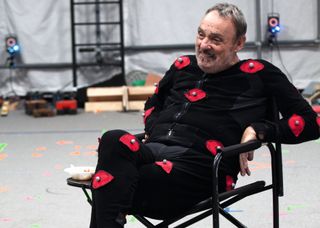Meeting the stars of Star Citizen

“You need the emotion, you need the performance,” Roberts says. “A lot of the technology is just having tools that allow you take that from the real world, and map it into the digital world where people can look at it from different angles. It really does look like we’re back being five years old again, pretending to fly spaceships and blow stuff up—but trust me. It’ll all look really good at the end of the day.”
A production like this changes the way the actors ordinarily work, but both have taken to it positively.
“This is really stripping it down to basics,” Hamill says. “It’s very equalising to see everyone dressed exactly the same way—it doesn’t matter if you’re a principal player or a background artist. You spend a lifetime on movie sets, doing television and what-not, and you think you know something. Here you’re going back and learning it all over again.”
“It’s like being back in school,” says Rhys-Davies. “You come along and think ‘eh, I’ve done a few films, I know what I’m doing’ and you get there and very patiently your director has to spell it out to you.”
“Somebody on set today held up a sign that made me laugh,” Hamill says. “It said, ‘I love the way you act like you know what you’re doing’. I thought ‘boy, does she have my number’. It’s like being a child again, playing Robin Hood in your backyard. It’s all pretending.”
Rhys-Davies agrees. “There we are, with our suits full of these little pimples, and these planks of wood, going ‘RIGHT! THEY’RE COMING! KEEP YOUR HEAD DOWN! QUICK SHOTS!’”

Neither actor plays games regularly, but talking to both I get a sense of their interest in the medium and the way it can tell stories. Rhys-Davies is excited by the potential for games to train doctors, soldiers, and diplomats, to allow for the simulation of history. Hamill is interested in the way acting can provide a reactive backdrop to the player’s actions. “You’re part of this gigantic puzzle, in a way. You’re providing each little piece so that the player can put together their own scenario. I find that fascinating.”
PC Gamer Newsletter
Sign up to get the best content of the week, and great gaming deals, as picked by the editors.
They express infectious enthusiasm for the project and for working with Chris Roberts. “Once you ask the technical people to show you the images, you are filled with awe,” Rhys-Davies says. “I mean, a spaceship a kilometre long. A mining station five, six, seven kilometres.” He pauses so dramatically I almost laugh out loud. “Our dreams will have to be pretty big to keep up with the size of space , though, won’t they?”
Star Citizen and Squadron 42 warrant a little scepticism, to the extent that any massively ambitious crowdfunded production does, but the project as a whole seems much more real to me, coming away from Ealing. When will we play it? I don’t know—but I’m more confident that we will, particularly in the case of Squadron 42. After all, these three people have already made a game like this before.
“It was a very interesting experience last time around,” Rhys-Davies says. “You had the sense that it was state-of-the-art, and there was the slight question of whether it would work or not—and it worked, and it worked brilliantly.”
“This one has its own feel,” Hamill adds. “It’s still as much fun, but what was cutting-edge a couple of decades ago probably looks antiquated to modern-day game players.” He gestures to Chris Roberts. “He’s right on the edge again with this one.”
“Dragging two bewildered actors with him,” Rhys-Davies adds.
Joining in 2011, Chris made his start with PC Gamer turning beautiful trees into magazines, first as a writer and later as deputy editor. Once PCG's reluctant MMO champion , his discovery of Dota 2 in 2012 led him to much darker, stranger places. In 2015, Chris became the editor of PC Gamer Pro, overseeing our online coverage of competitive gaming and esports. He left in 2017, and can be now found making games and recording the Crate & Crowbar podcast.

Boasting economist lobstermen, gas mask aliens with 120 sexes, and the best space dogfights 2003 has to offer, Underspace is a sci-fi RPG well worth your time

Paradox apologizes for latest Cities: Skylines 2 boondoggle, will give refunds for the Beach Properties DLC: '[We] hope we can regain your trust going forward'
Most Popular



